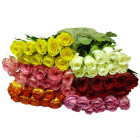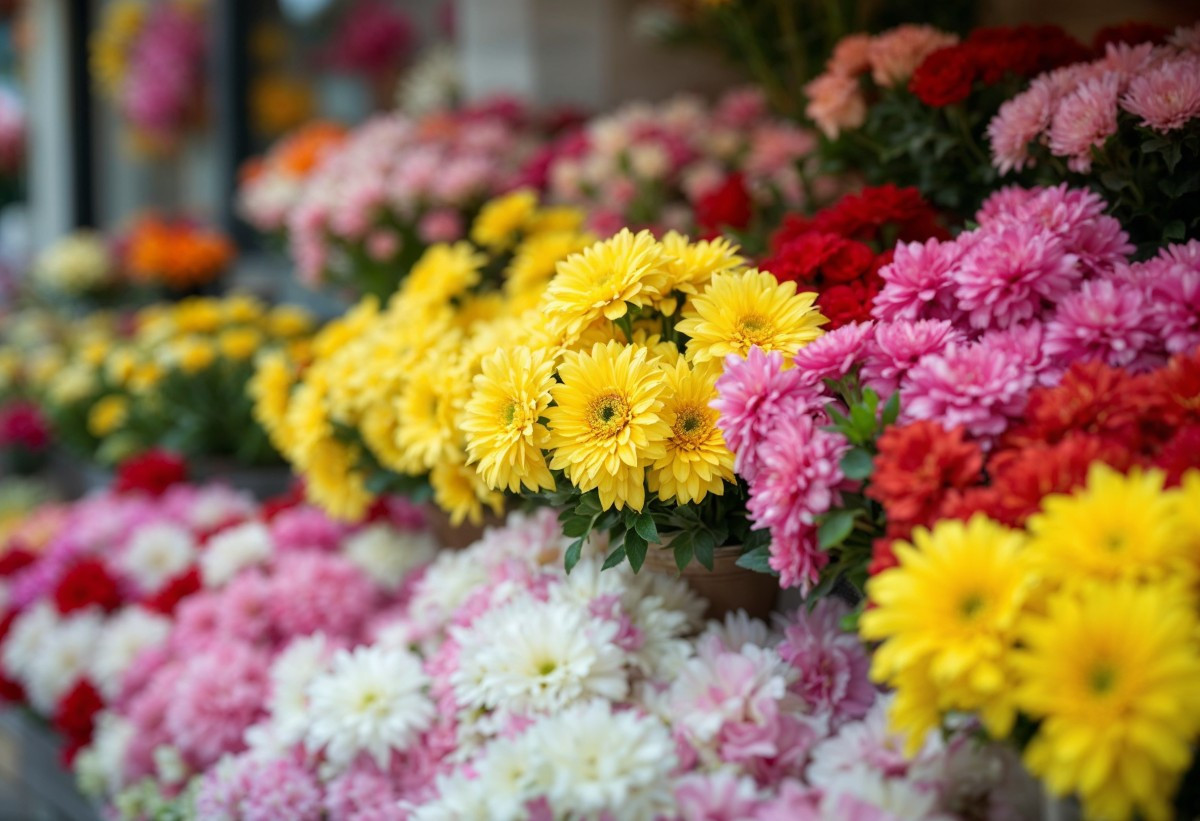
How to Boost Flower Shop Sales, from Window Display to Loyal Customers
The flower business may seem straightforward, but behind the scenes it can be quite intense. Sometimes it’s hard for a shop owner to grasp why revenue suddenly drops, even when the assortment looks fresh and the staff is doing their best. The problem isn’t always price or seasonality. Quite often, it’s that the promotional strategy has stagnated, the window display no longer attracts passersby, or regular customers aren’t seeing anything new. This isn’t just about a one-time effort; a systematic approach is needed to build trust and ensure steady growth.
Imagine your flower shop as a living organism. It has its own ecosystem: product range, window display, advertising, and customer relations. When one element falters, the entire organism suffers. But once you find that equilibrium, sales begin to climb again, and customers return. In the following sections, we’ll talk about how to better understand your audience, adjust pricing, improve your product presentation, and explore additional sales channels. The key is to move gradually and stay alert to any feedback.
The First Step Toward Higher Sales
Identifying Problems and Setting Priorities
Before you change prices or overhaul your window display, it’s crucial to pinpoint the root cause. Perhaps your range of flowers is out of date, and customers are craving new arrangements or rare varieties. Maybe your advertising doesn’t capture the shop’s uniqueness, and your current positioning isn’t attracting new faces. Sometimes the reason is that your service no longer delights buyers, so they look elsewhere.
Try listing all the possible reasons why sales have stalled or declined. Next, figure out which are the most critical. If you discover a shortage of new customers, work on promotion and the display. If your loyal clientele is drifting away, maybe they haven’t been wowed by any special offers or personalized touches recently. Pick a few main areas to improve and tackle them step by step.
Evaluating New Customer Flow and the Relevance of Advertising
If hundreds of people pass by your shop each day but only a few walk in, ask yourself how compelling your signs and display are. Perhaps your posters look dated, your social media ads are no longer effective, or your promotions haven’t been refreshed in ages. Could you create enticing mini-offers, short but catchy newsletter campaigns, or a small bonus for first-time buyers to spark curiosity?
You don’t have to spread yourself thin across every platform. Check which channel best matches your audience. If it’s a neighborhood chat group, share updates about your shop there in a friendly, informal tone. If people are constantly Googling bouquets, focus on internet marketing. Your goal is to attract newcomers and show them there’s something fresh and exciting on offer.
Checking Your Hours and Customer Convenience
Small details can have a big impact. Does your shop open too late, missing the early crowd? Or do you close before people come home from work? Try adjusting your schedule to match those patterns. Maybe open slightly earlier or stay a bit later around major holidays. If a customer finds it convenient to drop by at a certain time, why not make that possible?
Sometimes, it helps to think about extra services: quick delivery, background music, hooks for bags, or bike parking. These little touches create an ambiance people enjoy returning to. Suddenly, you’re not just a seller, but a welcoming host where they can stop on their way home with minimal hassle.
Understanding Customers and Fine-Tuning Your Product Range
Surveys, Feedback, and Engaging with Regulars
Why not speak directly to those who’ve become your biggest fans? Regular customers can provide insight into what they like or dislike. Maybe some love bold, exotic blooms while others prefer simple, traditional bouquets. Ask them if they’re satisfied with the prices, the service, and where things are placed in the shop.
You can do this in person, offer a quick questionnaire, or invite them to leave feedback via messenger. The information you collect is invaluable for refining your assortment. If most people adore roses but want rarer shades, why not expand that lineup? If someone complains about limited wrapping options, consider increasing your selection of ribbons and papers.
Marking Holidays and Individual Preferences
Not everyone buys flowers once a year. Some need them for a friend’s wedding, someone else for a mother’s birthday, and another for a corporate event. By noting your customers’ important dates (with their permission), you can remind them at just the right time, offering to prepare and deliver a bouquet for the special day. It shows that you’re doing more than just selling—you’re paying attention.
If a customer always wants peony-shaped roses or delicate peonies, you could give them a heads-up when a fresh batch arrives. Such personalization demonstrates that you remember your customers’ tastes and aim to meet their needs without repeated prompting.
Personalized Outreach and Special Offers
Think of yourself as a personal florist for each regular customer. Segment your audience: classic enthusiasts, lovers of rare varieties, and budget shoppers who still want a pretty bouquet. Plan which promotions or new items to highlight for each group. Some might appreciate modest but stylish single-variety bouquets, while others could be drawn to a hands-on workshop or an unusual blend of exotic blooms.
Send out targeted announcements describing your latest arrivals or any upcoming delivery of premium blossoms. This way, clients feel uniquely addressed, recognizing that you’re speaking their language and catering to their specific preferences.
Pricing Strategy and Perceived Value
Balancing Cost and Quality Impression
Pricing is always tricky. If it’s too low, people may suspect your flowers aren’t fresh. If it’s too high, you might scare off part of your audience. It’s crucial to make buyers understand they’re paying not just for the flowers, but for the emotional impact, the service, and your quality guarantee. Perhaps a modest price bump is fine if you improve the packaging or include a small bonus, like a handwritten card or a scented candle—something that demonstrates personal care.
Place brief descriptions by each bouquet: where the flowers come from, what makes them special, how long they typically last. Even little details can justify the price. If customers sense it’s more than just stems, and realize there’s genuine floristic craftsmanship involved, they’ll be more comfortable with your pricing.
Adjusting Prices During High Demand
Holidays are a time when demand soars. Modest price increases can be acceptable if you’re putting in extra work with suppliers, sorting, and packaging. But don’t go overboard. A holiday could be the perfect opportunity to offer not just higher prices, but also better pre-order options, charming gift wraps, or loyalty perks for a future purchase.
This not only justifies any price shift but also shows that you’re not out to exploit the rush—you’re adding more value. For instance, consider a special set for International Women’s Day or Teacher’s Day—a bouquet paired with a cute postcard. People will then realize what exactly they’re paying extra for.
Introducing Exclusive Arrangements for Enthusiasts
Not everyone wants the usual set of roses or chrysanthemums. Some are willing to pay more for rare varieties, unusual color combinations, or bouquets in striking shapes. Consider launching a limited line of arrangements that aren’t found in your regular selection. You can decorate these exclusive pieces with special packaging, give them memorable names, and emphasize their one-of-a-kind nature.
Even if these bouquets sell less frequently, they create a perception that your shop values originality and isn’t afraid to experiment. That means you’ll attract a clientele ready to pay for a unique experience, not just a run-of-the-mill bunch of flowers.
The Window Display as an Attention-Grabber
Visual Presentation, Lighting, and Accents
Your window display is your outdoor billboard. If a passerby sees a dull cluster of stems with no clear theme, there’s little incentive to walk in. But if the display tells a mini “floral story”—with varied lighting, a balanced mix of bright and pastel hues, interesting containers, or an imaginative layout—it can catch someone’s eye. Instead of a haphazard pile of bouquets, arrange a thoughtful composition that showcases both large and small flowers, along with unexpected details like decorative twigs or dried elements.
Don’t be afraid to experiment. Sometimes a slightly dimmer light and bouquets placed on different levels can look more appealing than a brightly lit but monotonous shelf. The main thing is not to overfill the space, so customers can focus on individual items instead of feeling overwhelmed.
Arranging Bouquets by Price Bracket
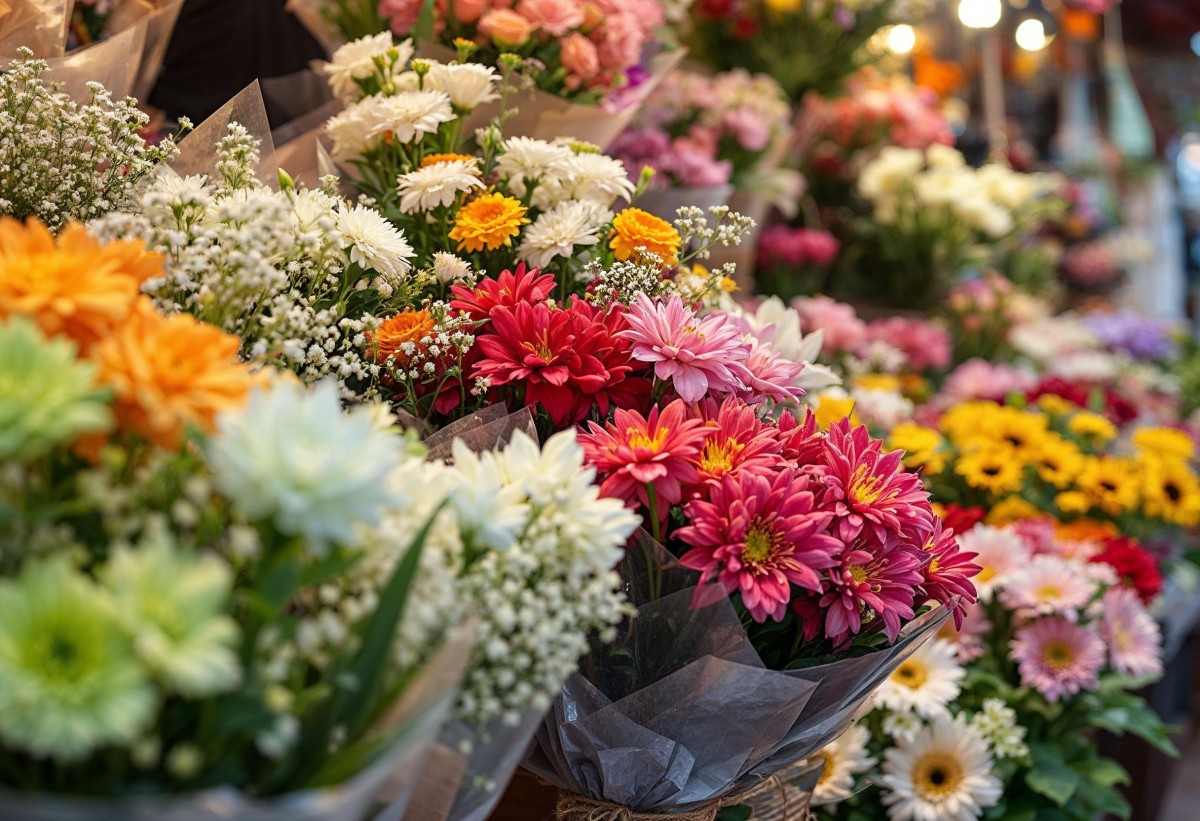
Picture a customer who just walked in and is trying to get oriented. If pricey bouquets are mixed up with budget-friendly ones, and mid-range options are hidden somewhere out of sight, it complicates the choice. It’s helpful when there’s a logical system: perhaps affordable bouquets on the right, mid-range in the center, and premium on the left—or vice versa.
It’s similar to how clothing stores arrange items by price or style. This makes it easier for the customer to find what fits their budget, while you enjoy smoother sales. If people can quickly decide on a spending range, they’ll hesitate less and be more inclined to buy.
Seasonal Updates and Thematic Variety
Seasons change, and so do flowers. In winter, red and white tones with fir branches or berries are appealing; in spring, soft pastel palettes with tulips. Summer calls for bright, sunny blooms, while autumn leans toward deep shades, dried plants, and seasonal berries. By adjusting your window display to match the time of year or an upcoming holiday, you show awareness of the current context.
You don’t have to completely rearrange everything each time. A few decorative additions or shifting the focal points can do the trick. Shoppers appreciate a store that aligns with the seasons. It feels like visiting a friend whose home also transforms throughout the year, adding a cozy, natural vibe.
Additional Sales Channels and Audience Expansion
Marketplaces, Online Catalogs, and Aggregators
The internet hasn’t been a novelty for ages—nowadays, plenty of people order bouquets without leaving their couch. Listing your shop on marketplaces or gift aggregators broadens your potential audience. Some users may stumble upon your listing in a catalog and get interested, even if they’d never heard of your shop before. It’s crucial to include a clear product description, attractive photos, and straightforward delivery terms.
You can also boost your reputation by handling logistics effectively and gathering positive reviews. Ask satisfied clients to leave a brief comment. It builds trust and shows that you care about quality, not just making a sale. Special attention should be paid to search terms: people often type specific flower arrangement names or simply “buy bouquet with delivery.” Think about simple, relevant keywords that match these searches.
Corporate Clients, Contracts, and Steady Demand
Sales aren’t just about walk-in customers. There are also corporate clients—businesses that regularly need floral arrangements to decorate their offices or congratulate employees and partners. These orders can repeat on a predictable schedule, generating consistent revenue. Drafting contracts with smaller companies or restaurants that often renew their floral decor helps you plan inventory and forecasting.
To cement these partnerships, you might offer tailored services like fixed delivery days, discounts for bulk orders, or even guidance on picking a style. If handled right, you gain a reliable sales channel that isn’t as volatile as regular foot traffic.
Synergy with Delivery Services
Modern life is fast-paced, so many people don’t have time to drop by in person. Partnering with a courier company makes shipping easier and extends your reach to more customers. It allows you to quickly address urgent orders or spontaneous “need it today” requests, and it greatly benefits busy shoppers.
You can negotiate fixed delivery rates, set up special offers for returning clients, or opt for branded packaging that reminds customers of your shop. This spares them the stress of logistics and highlights your professional approach. They’ll feel confident that a bouquet ordered from you will arrive promptly, looking great and without hassle.
Working with Regular Customers
Building a Client Database and Organizing Customer Details
It pays to remember those who have already chosen your shop. Keeping track of contacts, birthdays of important people in a client’s life, or their favorite flowers is an investment in future sales. You can then recommend a special bouquet for upcoming dates, or let them know about new stock of their beloved peonies.
One small tip: avoid turning data collection into an interrogation. Keep it laid-back and let clients mention personal dates or preferences at their own pace. Over time, this database becomes a treasure trove, allowing you to offer thoughtful attention rather than just merchandise.
Regular Reminders, Mailing Lists, and Valuable Insights
Don’t wait for someone to recall your shop on their own. Gentle, relevant emails or messages featuring fresh ideas, seasonal specials, or bouquet care tips keep you on people’s radar. It’s not necessary to bombard them with pushy ads. Instead, share something useful: how to extend a bouquet’s life, the best holiday picks, or ways to pair flowers with small gifts.
When customers see you’re not simply trying to sell them something, but actually offering helpful info, they’ll view you as a valuable source. That fosters trust, and trust often translates into more sales.
Loyalty Programs, Bonus Points, and Referral Deals
Your loyal patrons are the true goldmine of any flower shop. To motivate them to return time after time, consider implementing a simple, easy-to-follow loyalty system. For instance, you could award bonus points for every purchase, which customers can redeem on their next order, or offer a discount on a high-end arrangement after a certain number of purchases.
If people are pleased with your service, they’ll tell their friends about you. You might add a referral code: invite a friend and receive a small gift or bonus. This way, clients become brand ambassadors, and you build a broader network of devoted customers.
Partnerships and Cross-Promotion
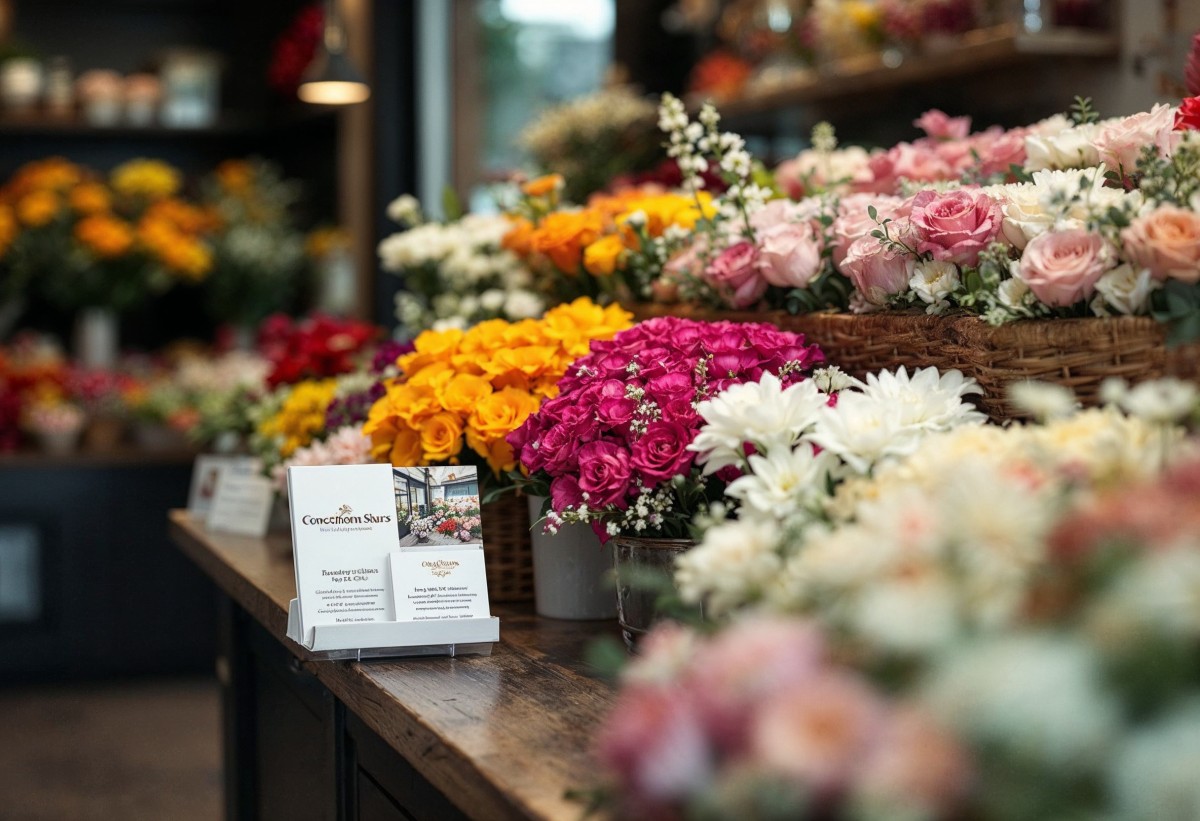
Joint Promotions with Cafés, Confectioneries, and Salons
Flowers often go hand in hand with other enjoyable treats—like sweets, stylish accessories, or gourmet items. Why not collaborate with a nearby café or pastry shop? You might set up a deal where a customer buying a dessert receives a discount on a bouquet at your shop, while you get a voucher for their cake in return.
Such partnerships make each purchase feel more valuable. A customer might think, “I’ll grab flowers here and something delicious right next door—perfect for a quick, all-in-one gift.” This approach strengthens your foothold in the local market, since collaboration exposes you to new audiences.
Exchanging Business Cards, Coupons, and Shared Advertising
It’s sometimes beneficial to arrange a simple swap of promotional materials. For example, you could host a stand with a beauty salon’s business cards, while they display your leaflets. If you already have a core group of repeat customers, spotting partner recommendations might spark their interest in those services—and vice versa. It’s mutually beneficial: you broaden your influence, while your partners gain access to your client base.
You could occasionally produce a combined flyer listing promotions from multiple neighboring shops or service providers. Many people appreciate bundled offers that put everything at their fingertips.
Comprehensive Gift Bundles for Group Gifting
Why not create enticing gift sets that include not just flowers, but, say, a box of chocolates from the pastry shop next door or even a spa certificate from a nearby salon? This “complete experience” would appeal to anyone seeking a ready-made, eye-catching present. At the same time, it’s a great chance to increase the average receipt and introduce customers to your partners.
Leveraging Local Communities and Word-of-Mouth
Being Present in Parent Chats and Neighborhood Groups
District message boards, parent chats, and local blogs can be wonderful platforms to talk about your shop—without resorting to hard-sell tactics. You might post something like, “We’ve recently introduced adorable children’s bouquets for the first day of school” or “Our new mini-arrangements are perfect for teachers.” People appreciate it when you offer easy, personable updates.
It’s also simple to gauge interest in these groups: you’ll see right away whether your idea resonates. If so, you can expand on it; if not, you can adjust your approach. These are low-cost, low-risk experiments.
Friendly Tips, Reviews, and Soft Promotion
Imagine a happy buyer recommending you to friends: “Not only do they have fresh flowers, but also great little perks and super-friendly staff.” If you want to encourage more of these spontaneous shoutouts, try being honest, offering helpful suggestions, and thinking up creative solutions. You don’t have to sell every single time—a quick floral tip or a note on how to keep a bouquet fresh can be just as helpful.
This tactic fosters an atmosphere of trust. People are far more inclined to listen to acquaintances than to an ad. Even if they don’t purchase something immediately, they might remember you when they need a special present down the road.
Word of Mouth as a Major Magnet
Word-of-mouth is one of the oldest marketing tools, but it’s still incredibly powerful. If satisfied customers speak well of you, it outshines any advertising campaign. Ask yourself, “What makes people talk?” Maybe it’s an unconventional approach, a quick fix to a small dilemma, a complimentary accent with each bouquet, or a genuinely warm reception. Small gestures—like a free greeting card, an unexpected discount for repeat buyers, or a sincere smile—create a positive memory that folks are eager to share.
Events and Direct Connections
Flower-Arranging Workshops for Enthusiasts
Not everyone comes to your store just to buy bouquets. Some find the design process itself fascinating, or they might want to learn how to combine colors effectively or properly prep stems. Hold a casual workshop. You could charge a symbolic fee or even offer it free to loyal clients.
Anyone who picks up new skills from your sessions will remember your store as a place that shares knowledge and fresh ideas. They might not ramp up their purchases right away, but they could tell friends about that workshop—feeding once again into the power of word-of-mouth.
Themed Gatherings and Clubs for Regular Clients
Why not turn your store into a small hub for flower lovers? Schedule occasional meetups—perhaps a “Peony Evening” or a “Rose Day”—where people can chat about their favorite varieties, explore new stock, and get the florist’s perspective. It’s a way to build deeper connections with your customers and even turn them into a genuine community.
Not everyone will show up, but those who do are likely to become even more loyal and, in turn, recommend you to others. This transforms your shop from a mere point of sale into a space for shared interests and a common love of beauty.
Engaging Bloggers, Experts, and Influencers
A local blogger with a modest but dedicated following can become a valuable ally. Invite them to a workshop, offer a bouquet with an interesting backstory, and kindly ask for their feedback. If it feels genuine and not too pushy, they might mention you in their stories or posts.
By doing so, you tap into their subscriber base, which already trusts their opinions. Of course, you need to select bloggers whose interests align with yours—people who appreciate aesthetics, cozy atmospheres, and unique concepts. Their followers are then more likely to embrace your appearance as natural, rather than seeing it as a paid promotion.
Competitor Analysis
Observing neighboring shops helps you figure out what they emphasize—some might impress customers with unusual varieties, others focus on locally sourced blooms, while another excels at vibrant seasonal specials. By comparing their approaches with your own style, you can pick out ideas that suit you, adapting them in a way that doesn’t make you lose your distinct character. From competitors, you don’t want an exact copy but rather a spark that inspires new directions.
Sometimes it’s even helpful to direct a customer to a neighboring shop if you don’t carry the item they’re looking for. Naturally, you won’t make a sale this time, but you’ll come across as open-minded and considerate. This fosters an aura of trust around your store—people remember such gestures and often return or mention you to friends. It’s a strategy that pays off in the long run, shaping a positive reputation and fortifying your shop’s standing in the community.
Quality Control and Service Enhancement
Mystery Shoppers for Objective Feedback
Sometimes a shop owner is certain their staff is flawless, but actual customers may see it differently. To get an outside perspective, hire a mystery shopper. They’ll pose as a typical visitor, place an order, and then report on whether the service was friendly, how quickly the staff understood them, and whether they offered anything extra beyond the standard purchase. This method removes the “rose-colored glasses” and highlights problems employees might not admit to themselves.
The insights you gain can reveal gaps in performance. Perhaps the florist is too quiet, or on the contrary, talks too much and distracts the customer from choosing a bouquet. Maybe the cashier forgets to offer extra packaging or mention small loyalty perks for repeat buyers. The goal is to examine every detail, even if it seems small at first glance.
Addressing Issues Uncovered by the Findings
When shortcomings surface, taking action is essential. For instance, if the mystery shopper noted that the checkout process was too slow, streamline it. If it turned out you never mentioned delivery options, remind the staff about your sales scripts, which outline each step of customer interaction. This shouldn’t feel like a punishment, but rather guidance—you’re giving your employees the tools to improve.
Try discussing the results with your team. Instead of lecturing them, have a constructive conversation on how to create a better atmosphere. If training is needed, hold a short seminar. If you need to tweak your logistics or refine the store layout, go for it. The clearer your process is for resolving issues, the faster your shop can move toward higher service quality.
Upgrading Service to Boost Repeat Sales
High-caliber service is a key factor that keeps people coming back, time after time. Even if your prices are higher than a competitor’s, customers are willing to pay if they receive personal attention and comfort. Returning buyers appreciate it when they’re remembered and offered exciting new items, when there’s no long queue, and when the team can adapt to their mood and preferences.
You could post small reminders or prompts for your staff: cheerful signs in the break room, a mini-presentation on handling complaints swiftly. These small touches can uplift morale and promote a more authentic interaction with your clientele. As a result, people leave with a smile and come back for another bouquet the following week—or even better, bring their friends along.
Using Loyalty Systems Without Direct Discounts
Purchase Bonuses and Inspiring Repeat Visits
Standard discounts are the simplest approach but not always the most profitable. You could encourage returns by awarding points for each purchase—say, a certain number of points for every bouquet above a certain price, which customers can then redeem on their next visit. It’s more intriguing than a “10% off” sign, because it introduces a bit of a game: accumulate, redeem, and enjoy the reward.
You can also develop different loyalty tiers, where the amount of bonus grows as the customer’s total purchases increase. This makes them feel that you appreciate their loyalty and want to reward it, essentially creating a club of returning buyers who are proud to belong.
Personalized Offers Based on Client Behavior
If a customer always buys a particular bouquet style, why not send them a personal offer for exactly that type, or let them know when a fresh batch arrives? If someone loves a variety of wrapping options, you could inform them about newly arrived ribbons or fashionable packaging. This kind of tailored approach makes it clear your shop interacts with each person individually, rather than with a crowd.
It can be managed using the same CRM systems that store purchase histories. Data on a customer’s preferences can be turned into specific promotions. It feels caring and prevents you from squandering energy on widespread promos that don’t reach the right audience.
Creating a Strong Base of Repeat Customers
When loyalty becomes more than a quick discount, it evolves into a meaningful bond between your shop and the clientele. Gradually, you build a solid core of customers who feel comfortable in your store, trust that you’ll offer them fresh ideas or rare varieties, and enjoy the sense of familiarity you’ve established with them.
That core assures you stable sales, even in quieter times of the year. Moreover, satisfied regulars often recommend the shop to their friends, organically widening your customer circle at minimal cost. Ultimately, you’re not just running a store—you’re fostering a community that’s attached to your brand.
Automation and Inventory Control

Leveraging CRM and Analytics Tools
For a flower shop owner, it’s extremely helpful to have a clear snapshot of what’s selling well and what’s gathering dust. Which days see a notable spike in demand, and how many buyers come back for a second purchase? Without data analysis, it’s hard to decide on the next steps.
CRM platforms and analytic solutions help systematize this information. They track sales figures, follow customer behavior, and note which flower varieties are most popular. This forms the basis for wise decision-making: you can stop stocking flowers that barely move and give more space to those your regulars truly adore.
Shaping Your Lineup with Sales Data
Let’s say you notice a sudden jump in demand for wildflower bouquets at some point. That might mean you should expand that category, explore new wrapping ideas, or even launch a “free card” offer. If, on the other hand, certain items almost never sell, it might be time to remove them or replace them with something more appealing.
Data is your ally, revealing where the focus should be. This prevents random guesswork and allows for intentional, targeted moves. Knowing what people expect helps you revamp your selection, raising sales without shooting in the dark.
Prudent Purchasing and Cutting Waste
Flowers have a limited shelf life. It’s pointless to order too many if half will wilt before they find a home. By examining your sales numbers and client preferences, you can buy just what you know will sell in a realistic time frame. That lowers spoilage and keeps your stock looking vibrant.
Ultimately, it means better inventory control, fewer losses, and reduced expenses. The resources you save can be reinvested in new flower varieties, upgraded store décor, or marketing campaigns. The shop runs more smoothly, without chaos or unforeseen costs. This sense of order also resonates with customers: they see fresh blooms, neatly arranged bouquets, and a store that cares about quality rather than short-term gains.
Digital Presence and Online Sales
A User-Friendly Website and Straightforward Product Catalog
Modern consumers frequently search for flowers online, and a streamlined experience matters most. If your shop’s website feels like a maze, visitors will leave without picking out a single bouquet. It’s better to keep things crystal clear: feature vibrant photos and concise descriptions on the homepage, plus well-organized categories by type, size, or color in the catalog. It also helps to include details like shelf life or care recommendations.
Pay attention to seemingly minor points. Handy filters, images from various angles, and clear notes on delivery availability can all dispel doubts and questions. The fewer steps from the moment someone opens your site to completing a purchase, the more likely they are to become loyal buyers. You might add user reviews or short notes highlighting what makes each composition special. Most importantly, make your online presence just as welcoming as your cozy physical shop.
Social Media and Messaging Apps to Expand Your Reach
Social networks are dynamic environments where people spend a considerable amount of time. You don’t have to limit yourself to simply posting bouquet photos. Engage your audience, respond to inquiries, and spark inspiration with fresh ideas. It’s not solely about standard posts—feel free to share short videos showing how you assemble bouquets, fun facts about different flower varieties, or behind-the-scenes glimpses. You could conduct polls, too: which blooms would they love to see more often? Interactive elements help you learn what people want while fostering customer loyalty.
Messaging apps are an excellent channel for quick interaction. Someone might ask whether you have a rare variety in stock or confirm delivery times, and you can respond almost instantly. This personal touch makes customers feel they’re dealing with a familiar florist rather than a faceless company. Periodic short updates on new arrivals or special deals help maintain interest.
Promo Codes, Special Campaigns, and Building the Online Channel
You can stimulate online sales with small incentives. For instance, you might offer a promo code for first-time web orders or throw in free delivery past a certain purchase amount. Sometimes a themed campaign is worth it—like a seasonal bouquet selection at a discount, or a gift included with every order on particular holidays.
Just be careful not to rely on promotions too heavily, otherwise they’ll lose their novelty. It’s better when these offers pop up occasionally, encouraging customers to check in regularly for updates. Over time, they’ll expect your online store to have something compelling, returning more frequently and boosting your long-term sales.
Broadening Your Product Range Beyond Flowers
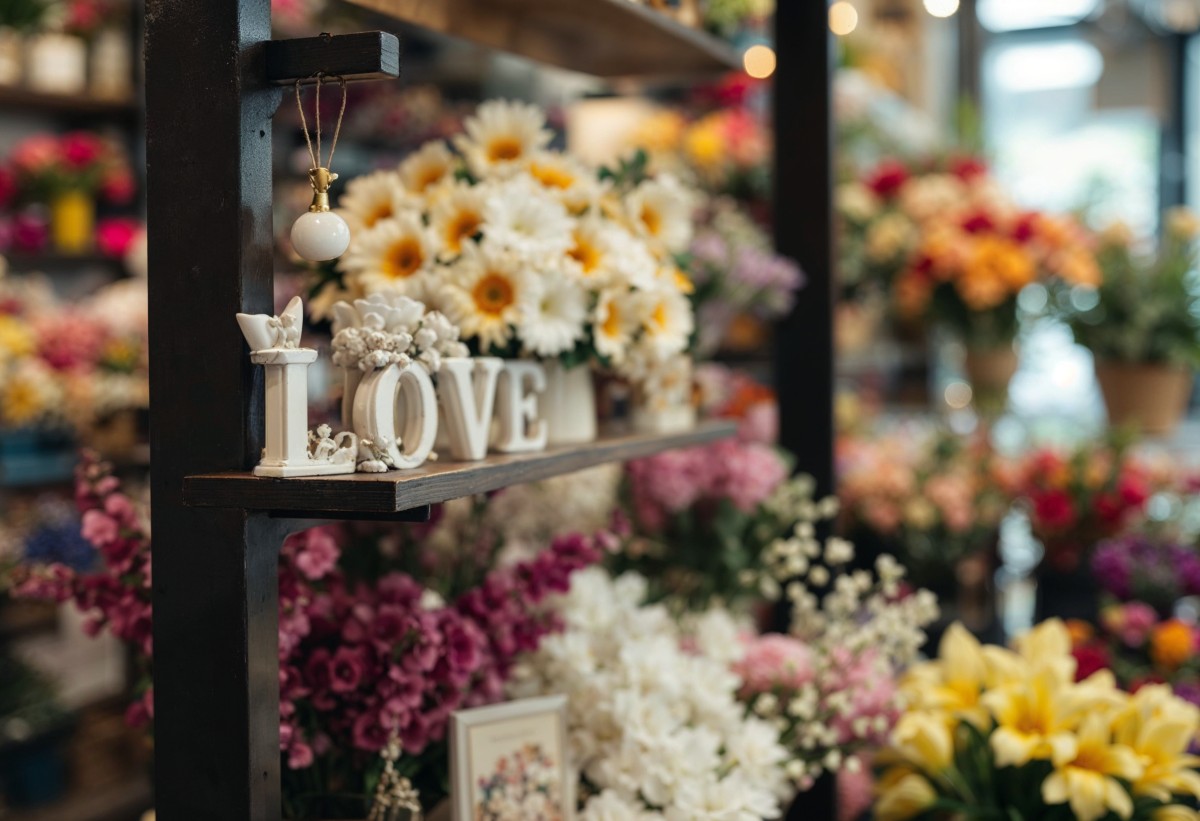
Adding Gifts, Chocolates, and Cards
Sometimes people crave not just a bouquet but an entire gift experience. Why not suggest a box of chocolates, a cute greeting card, or a tiny stuffed animal? These small touches round out the offering, turning an ordinary bouquet into a more complete presentation. Plus, these add-ons raise the average ticket—customers who’ve already decided to spend money on flowers often won’t hesitate to pick up something extra that complements them.
You could also expand into teas, scented candles, elegant vases, or small accessories. The key is choosing items that truly harmonize with the floral mood. If your shop style is calm and refined, classic souvenirs might fit best. If your brand identity is vibrant and bold, consider quirky trinkets or artistic postcards.
Putting Together Ready-Made Gift Sets
When time is short, pre-made bundles can be a lifesaver. Picture a customer rushing to a birthday party unsure how to enhance a bouquet. You’ve already solved that dilemma: a tasteful box with flowers, a note inside, maybe some sweets or another little surprise. It saves them time and increases your sales volume at the same time.
It’s crucial to consider the outward appearance of these bundles. Beautiful boxes, ribbons, and small accessories create that “wow” moment as soon as it’s opened. The more captivating the design, the deeper the impression. You can switch up these sets seasonally or around certain holidays, ensuring they remain fresh and appealing.
Boosting Your Average Spend with Extra Items
Shoppers often act on impulse. If they spot a tiny keepsake or an appealing trinket near the checkout that perfectly complements the bouquet, they may add it to the purchase on a whim. Psychologically, once they’ve decided on flowers, it’s easy to convince them to enhance the gift by paying a little more.
Still, it’s wise not to clutter the shop with random, unattractive goods. Aim for quality items that match your style. When every accessory beyond the bouquet is tastefully curated, customers notice that care and are more inclined to spend extra.
Preparing for Peak Seasons
Planning Purchases, Packaging, and Arrangements for Holidays
Holidays like International Women’s Day or Teacher’s Day can feel like a floristry frenzy. Demand skyrockets, time is tight, and stress levels rise. To avoid a meltdown, start planning well in advance. Determine which and how many flowers you’ll need, arrange deliveries with your suppliers for the holiday period, and stock up on packaging and decorative elements.
You could even make a short checklist: reserve your top-selling blooms, teach your staff some quick bouquet-assembling tricks, and prepare printed cards ahead of time. The clearer your plan, the less chaos you’ll face during those hectic moments.
Streamlining Logistics and Reinforcing Your Team When It’s Busy
Sometimes you have to hire extra couriers or bring in temporary help for assembling bouquets. Ask your regular employees if they can arrive a bit earlier or stay later. Plan the schedule carefully to avoid burnout. With well-organized logistics—vehicles fueled, drivers familiar with their routes, and packers fully aware of their tasks—holidays won’t be as stressful.
Don’t forget a contingency plan in case a supplier is late with part of your order. You can quickly adapt by substituting one kind of flower for another or recommending an appealing alternative. This ensures your reputation stays intact and spares you unnecessary tension.
Maximizing Service Efficiency During Rushes
When the big holiday arrives, customers are in a hurry. They want to grab a bouquet and go. Prepare a few ready-made options in different price ranges—from budget-friendly to high-end. Place them in plain view so you’re not caught up customizing each bouquet while crowds build up. Clear price tags, straightforward labels, and easy payment options all speed things along.
If you create a smooth, welcoming experience, customers won’t just come back—they’ll spread the word that your shop offers quick and reliable service. This is particularly vital during peak times when everyone’s stressed. The easier you make their shopping experience, the greater your advantage.
Reducing Expenses and Choosing Suppliers Wisely
Comparing Prices and Terms from Wholesalers and Local Producers
Suppliers are the source of your main goods, so it’s important to choose them wisely. Don’t settle for the first option that comes along. Compare quotes from multiple wholesalers, and check whether it’s possible to order from local growers who cultivate flowers nearby. Local suppliers sometimes provide fresher stock, plus you might save on shipping costs.
Don’t be shy about asking for bulk discounts or special deals for returning customers. Sometimes suppliers are open to negotiating if they see you’re in it for the long haul. These may be small perks, but they add up to significant savings over time.
Many florists have also started exploring international sourcing on their own. For example, Flora Market offers a convenient way to purchase batches of flowers from trusted suppliers in Ecuador, Kenya, Colombia, China, the Netherlands, and other countries, with delivery to a warehouse in Moscow. Not meant as an instruction, but rather a gentle hint at another helpful tool in your arsenal.
Finding Partners Who Offer Flexibility
There may be suppliers willing to adapt to your exact needs. Some can deliver smaller quantities more frequently, or even offer a bit of leeway on payment deadlines. Arrangements like these help maintain a steady product lineup without overspending on surplus stems that may just end up in the trash.
Mutual understanding forms the basis of strong partnerships. Ideally, you’ll find suppliers who grow along with you, understand what makes your shop unique, and provide the goods precisely when they’re needed. This helps you avoid unexpected costs and headaches.
Minimizing Waste Through Smart Planning
Sometimes it’s worth taking a close look at your figures: how many flowers sold last month, which varieties struggle to move, when demand peaks and drops off. These insights enable you to plan ahead. Rather than “we’ll just stock up and hope,” it’s better to order only what you know you’ll sell. That means fewer leftovers and wilting blooms—and more money in your pocket.
You might do a test run of a new batch of rare varieties (hello, Flora Market), see how well they perform, and then decide whether to increase your orders. Repeating this cycle of analysis and fine-tuning allows for a stable, strategic purchasing system with minimal waste.
Key Takeaways for Growth
A Holistic Approach to Increasing Sales
It’s tough to boost your revenue if you only focus on one area. You need to tackle multiple angles at once—revamping your display, refining service, expanding your selection, strengthening online sales, and forging solid supplier relationships. These steps together form a chain of improvements that steadily pushes your bottom line upward.
It’s also crucial to remember that a shop is a work in progress. You can’t just set it up once and relax. Tastes and customer needs evolve, and new floral or packaging trends emerge. Staying flexible and being ready to make small adjustments is the path to long-term success.
Data and Analysis Instead of Guesswork
Gut feelings can be useful, but relying on them alone is risky. You’re better off working with facts: how much was ordered, how many were tossed, which flowers became bestsellers, and at what time of day or year sales spike. Regularly looking at the numbers lets you make more informed choices. If certain bouquets sell like hotcakes while others lag, revise your lineup. If you notice declining engagement on social media, experiment with fresh content or new channels.
Data is your greatest ally. It won’t mislead or exaggerate—it simply tells you what’s happening. Pay attention to it, and use those insights to guide your decisions.
Gradual Innovation and Ongoing Evaluation
Avoid diving into every possible experiment at once. Introduce a small tweak—a new holiday-themed bundle, a slight change in store hours, or an alternative approach to social media—and see how customers respond. If you observe a rise in sales and positive reception, build on it. If not, don’t worry—try the next idea.
Such incremental steps reduce stress, limit the risk of major missteps, and allow you to track how each update performs. This creates a dynamic system that learns and adapts to shoppers’ needs.
Conclusion
Finding Your Signature Style and “Special Touches”
In the end, a flower shop is more than just a point of sale—it’s a place where people look for an emotional experience. Develop your own flair without becoming a clone of your competitors. Maybe your strength is unique teacher-oriented gift sets or bouquets that highlight exotic herbs, or perhaps your hallmark is an exceptionally welcoming service. Those “little extras” are what make your shop stand out.
Steady Upgrades to Service and Product Range
Service and selection form the foundation of your venture. Switch up the display, experiment with new varieties, train your employees, and test different ways of reminding clients that you’re there for them. As the small details improve, overall quality rises. Remember that customers notice your progress and appreciate it. The more you cater to their expectations, the stronger their loyalty.
A Source of Inspiration for Further Growth
Running a flower business is a captivating journey. Each step brings fresh ideas—maybe you’ll create a special-edition line, host an offbeat workshop, or team up with local artists to produce decorative bouquets. Let these possibilities energize you. Because the more passion and creativity you invest, the more dazzling your flowers become, and the more eager people are to return for the next delightful moment.








